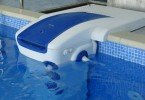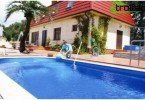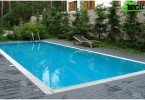Lighting and fixtures for pools
The pool is a place of active recreation, a place where the whole family gathers, a place where children hurry in a hurry before they wake up. That is why it is worth considering its design to the smallest detail, so that every minute spent in it gives only joy and happiness. A special role in the design of this structure is played by lighting. A variety of pool lights not only illuminate the water in the dark, but also create a special atmosphere that can be compared to the sunset in its beauty.
Content
- Lighting tricks and tricks
- Development of a pool lighting project
- Types of lighting for the pool
Lighting tricks and tricks
To illuminate the pools, various techniques are used:
- Poolside lighting
If the pool is inside the house, then it is advisable to use different types of lamps to illuminate it. One of them is the fixtures for the pool, which are mounted on the ceiling and walls. However, conventional appliances are inappropriate here, because the room has a high level of humidity. Therefore, special fixtures with an appropriate degree of protection against moisture are ideal for safe operation..
A very effective scheme for general lighting of the pool room is the side illumination, that is, lamps are installed on the walls. This technique is very successful in terms of ease of installation and further maintenance, because the lamps located along the walls are much easier to replace than those located directly above the water.
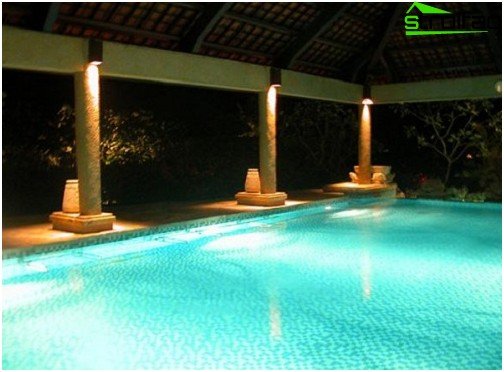
Option for general and local pool lighting
Another successful scheme is the reception of reflected light when the side lights are directed to the ceiling. In this case, the light will be scattered, as it were, creating a pleasant semi-intimate atmosphere.
Important: if you decide to use the method of reflected light, the ceiling in the pool must be light, and even better white.
- Local backlight
This technique is used when they want to emphasize. For example, to highlight a particular architectural element, highlight columns or luxurious stucco, a touching bridge or a living plant. The main thing here is not to make a mistake in choosing lighting devices and their correct arrangement. It’s better not to do such calculations, but to a specialist who picks up the optics and installs them, and finds the best place for the fixtures.
- Poolside perimeter lighting
This technique is appropriate to use for pools with unusual and original forms. Lamps are mounted directly on the upper part of the pool and effectively repeat its contour. In addition to the decorative function, this type of lighting also carries a functional load, because thanks to the contour lighting, you can easily navigate in space and clearly see where the land is and where the water is.
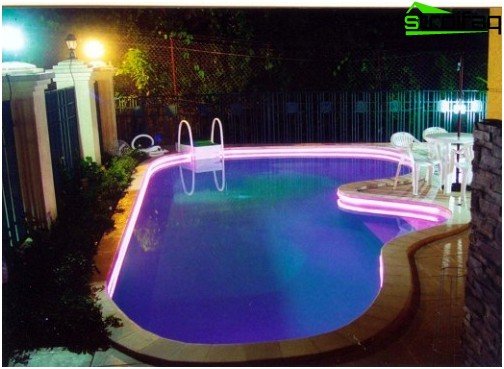
Fiber optic for pool lighting
- Illuminations
A variety of color effects are appropriate in any pool, because beautiful and unusual lighting is always fashionable. A wide range of devices equipped with color filters of different shades and with different patterns makes it easy to choose the most interesting option for yourself..
Thanks to such lighting devices, you can create a variety of effects: alternating color changes of water, attenuation or burning up of color spots, imitation of a rainbow, geometric shapes, etc..
Development of a pool lighting project
Of course, the pool is not a cheap pleasure, but if you thoroughly approached its construction and design, then you should not save on the project of lighting the future recreation area. You can independently develop a concept, come up with your own project, purchase everything you need (and unnecessary too, without it in any way), install and connect, but there are practically no guarantees that your work will be of high quality and the way you intended.
In order not to waste time and money, it is worth contacting specialists who, with an accuracy of a millimeter, will develop a lighting design for your pool. To do this, they will use a three-dimensional model, which will be a demonstration version of the recreation and relaxation area..
In case you were unsatisfied with the project and something does not suit you, there is always the opportunity to correct these or other shortcomings.
After you approve the lighting project, an accurate calculation is performed using special computer programs with real photometric data of the fixtures and other devices. And only when all the calculations are completed completely, you can proceed to the selection of equipment with the mandatory observance of all the instructions that are given in the project.
Types of lighting for the pool
So, the pool has been built, the lighting project has been drawn up, it’s all left to the small task of choosing the right fixtures and installing them. That’s just to start you need to navigate a variety of models.
- Lamps for lighting a pool room
These are the so-called general lighting fixtures. They can be very different: wall, ceiling, laid on, built-in, etc. Most often, such lighting fixtures have an industrial design, but if you search, you can find very interesting models with original structural elements.
Due to the fact that general lighting fixtures have different types of reflectors, it is possible to create a unique project using computer lighting calculations.
There are also very unusual models that turn the pool lighting into a bright light show. Such devices consist of a housing with two openings (top and bottom). Due to the fact that the light goes in two directions at once, the effect of “soaring in the air” walls is created.
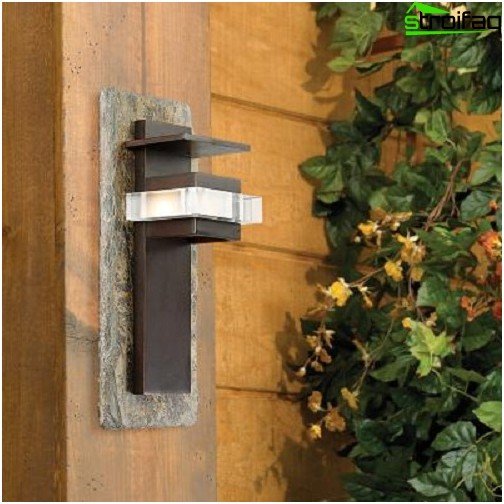
General lighting fixture for the pool
- Underwater lights
Underwater lamp for the pool – this is an opportunity to decorate the water surface, while giving it airiness and lightness. This type of lighting equipment has high requirements, because they must not only ensure electrical safety for people swimming in the pool, but also have a high level of moisture protection.
Recessed underwater lights can be mounted both in the walls of the pool and in its bottom. They can be overhead – it all depends on what goals the customer pursues. If he wants to create crisp and clear contours of light spots, then it is worth stopping the choice on built-in models. And if he prefers warm and slightly diffused light, then the choice should definitely be in favor of overhead lamps.
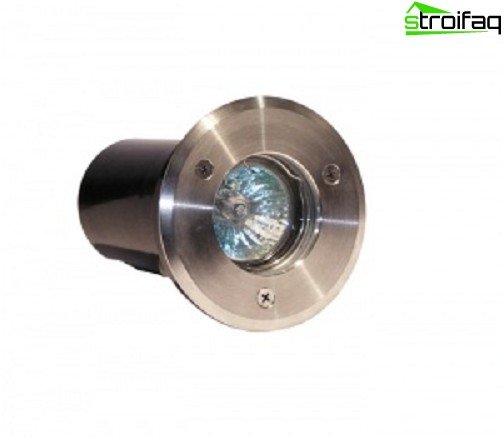
Recessed underwater light
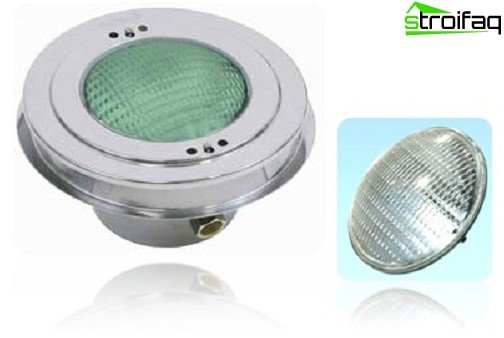
Surface mounted underwater light with filter
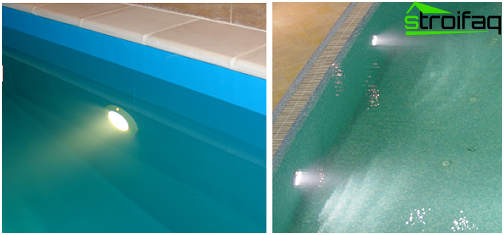
The option of designing a pool using an underwater lamp
When choosing underwater lighting fixtures for a swimming pool, it is necessary to take into account some points that may become a stumbling block.
- Maximum installation depth. This parameter is indicated by the manufacturer directly on the packaging..
- Body material. A quality pool light should only be made of plastic, stainless steel or bronze.
As a rule, halogen lamps are used as a light source in underwater lighting devices, but in recent years, LEDs have become more widespread. The latter not only shine brighter, but also much more durable and economical.
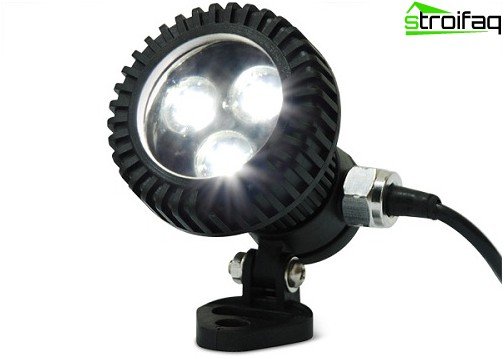
LED underwater light
- Lamps for contour lighting of pools
To clearly define the boundaries of the pool, they use light fiber, which is absolutely safe for humans, has a long service life (50 years or more) and is very flexible. It is the last parameter that allows you to implement the most daring ideas and design solutions.
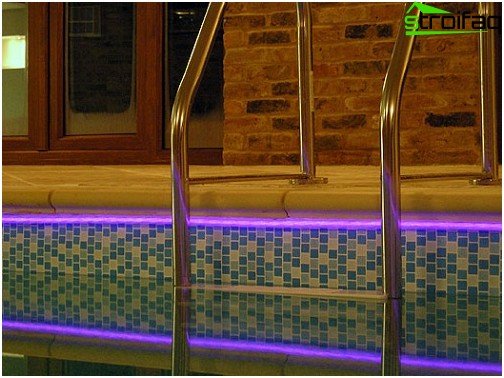
The design option of the pool side with light fiber
Important: when installing the optical fiber, please note that the power supply must be at a safe distance from the pool, otherwise a short circuit may occur.
Lighting pools with fiber optics is always designed individually for each case, so you can be 100% sure that your pool is unique and there is no second one. Filters of such a system can be connected to a computer and then you can independently create your own light and music show.
Of course, the cost of such equipment is quite high, but if you take into account the service life, then you will still save by installing fiber-optic contour lights in your pool.
Original lighting, clear water, comfortable relaxation areas – and your pool is a favorite place for all households.



